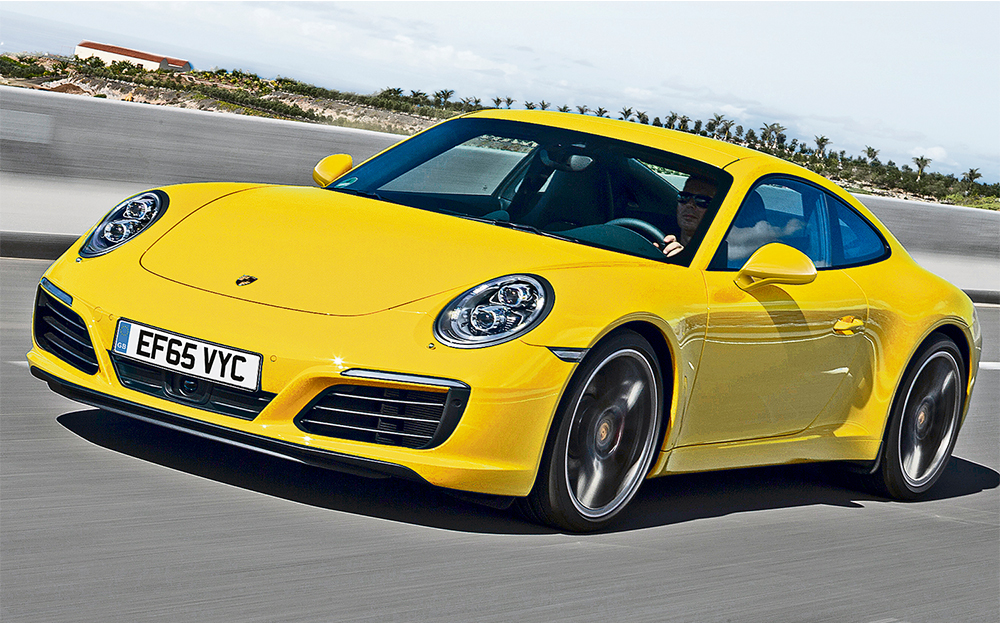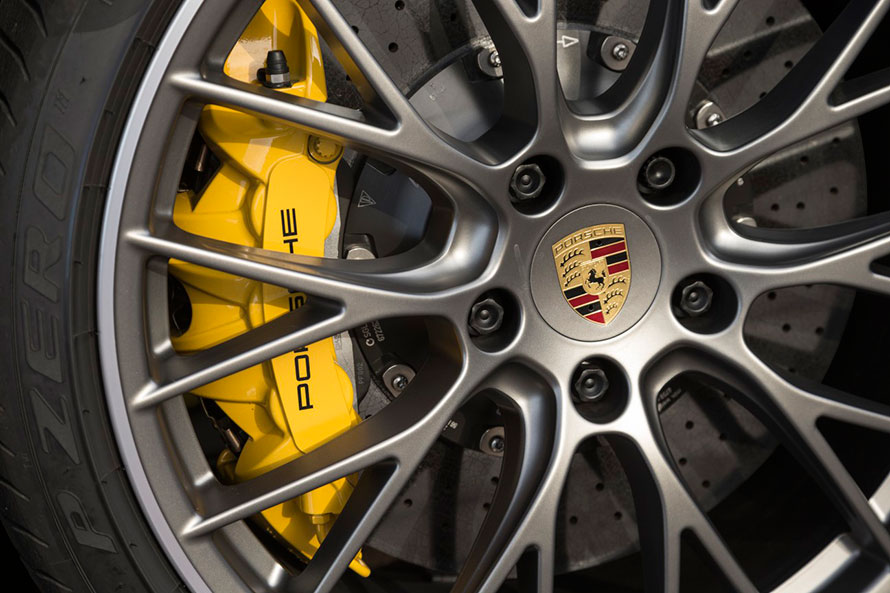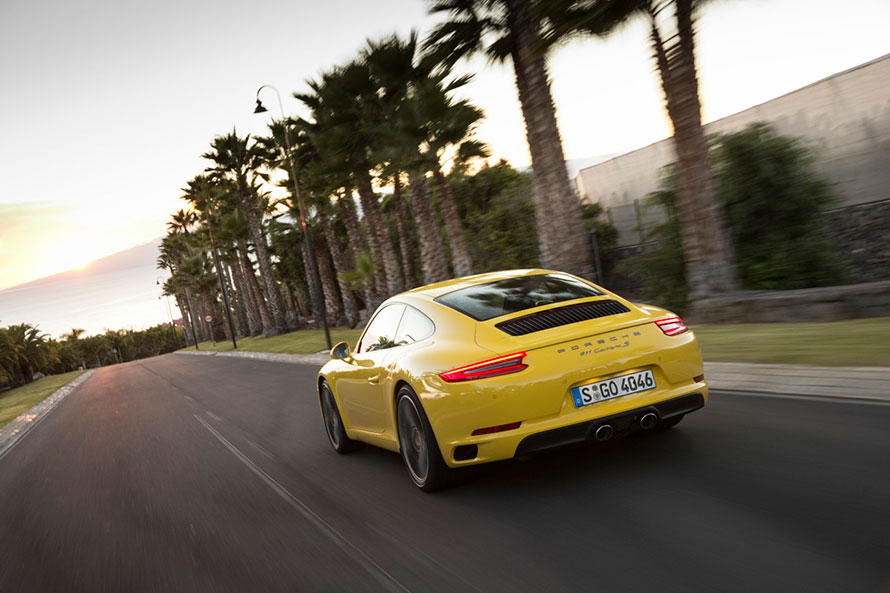First Drive review: 2015 Porsche 911 Carrera S coupé
Tear off into the distance as the bores blow their tops

THIS IS going to cause some beard-tugging at the owners’ club meets. Their beloved Porsche 911, born in 1963, has been fiddled with . . . again. First there was a cupholder; then an engine cooled by water, not air; then steering powered by electricity; and now, sweet mother of mercy, the “normal” Carrera has a turbo. With the exception of the odd motor sport special, there will never be another 911 that breathes unmolested air. It’s a seminal moment, the automotive equivalent of Wimbledon tennis chiefs declaring white a bit passé.
View the Porche 911 Carreras for sale on driving.co.uk
Porsche says it had no choice. Customer requests for yet more oomph had to be balanced by legislative demands for “increased efficiency” (in actual fact, lesser emissions). Aside from cheating (which German conglomerate would possibly do that?), the only viable solution was to turbocharge the flat-six engine. Gone are the old 3.4 and 3.8-litre motors, replaced by a 3-litre twin turbo available in two states of tune.
The entry-level Carrera now has 365bhp, while the more popular S has 414bhp. That’s an increase of 20bhp over the old models. More importantly, the S now has 45 lb ft more torque and it’s generated much lower in the rev range. Such stats may sound like motoring journalist geekery, but in the real world they are key to a shift in character.
You start the S with a key, not a button, which feels reassuringly retro. The engine settles to a melodic thrum that will be instantly familiar to drivers of the old 911. Pull away and you notice a change, though. As the rev counter nudges towards 2000rpm, there’s a distinctive whoosh from the turbo as it comes to life. Then a determined prod in the kidneys that never relents before the next cog is due.

It is brutally rapid and in pure performance terms a big step forward from the old model. Choose the PDK gearbox and Sport Chrono packages, and you have a car capable of 0-62mph in just 3.9 seconds and 191mph. It’s laughably easy to achieve. All you do is fire up the launch control, release the brake with your left foot and let the car do the rest. It makes even the most hapless pedaller feel like a hero.
For the owners’ club, this might actually be a problem. You no longer have to drive the 911 to make it fly. Such are the reserves of mid-range pull that fourth gear in effect turns the manual into an automatic. When you’re not in the mood, such lazy performance will seem a virtue, but anyone buying the Porsche as a sports car might find it all a bit too laid-back. Everyday versatility has always been a 911 forte, but then so too has a full-fat driving experience.
There’s also an inevitable smidgen of lag — the time taken between a prod of the throttle and the turbo coming to life. In early 911 Turbos this happened with excruciating slowness, but here it has been reduced to the blink of an eye. In truth, unless you’ve spent time in the outgoing 911, you probably won’t notice it, but if you’re an aficionado, you undoubtedly will. It’s the reason professional racers have tended to prefer the standard car to the faster Turbo — the razor-sharp throttle response that has always characterised a 911 has been compromised.

While we’re having a moan, it’s fair to say it doesn’t sound as good either. Turbo engines have always struggled to match the symphonic treats served up by the naturally aspirated alternatives. That’s part of the reason Formula One sounds so rubbish today. Again, all things are relative, and by conventional standards the 911 still plays an engaging tune, but by the standards of the old Carrera something has gone missing, particularly at the top of the rev range.
Porsche’s boffins talk about the new engine adding extra instruments to the orchestra, but we’d happily swap some turbo whistle for the return of the wolverine howl. The standard car is almost eerily quiet. If you want even the semi-skimmed 911 experience, you really need to tick the box marked sports exhaust and add £1,773 to your bill.
The point of all this, of course, is efficiency. The Carrera S with a PDK gearbox averages 36.7mpg and emits just 174g/km of carbon dioxide. That’s an improvement on the old model, but as you may well have noticed elsewhere in the news, you’ll be unlikely to match those figures in the real world. Use this car as the company’s founder, Ferdinand Porsche, originally intended and the consumption figure will probably drop to the teens.
The 911 has agility that no rival can match. Jaguar’s F-type R is a hoot and even more powerful, but it doesn’t come close to the Porsche’s fine tuning
Bolting in a new, marginally heavier engine also meant retuning the suspension and introducing a couple of extra gadgets. These include rear-wheel steering, a concept that went out of fashion in the 1990s but returned with aplomb in the 911 Turbo and GT3. Now it’s available on the “normal” 911 as, you guessed it, an optional extra (£1,530).
At low speed the rear wheels swivel in the opposite direction to those at the front to reduce the turning circle (good) and improve agility (also good). At higher speeds they turn in the same direction to improve stability (good again). It may sound a gimmick but it really works and, if you’re in the market, is worth the cash. The 911 has agility that no rival can match. Jaguar’s F-type R is a hoot and even more powerful, but it doesn’t come close to the Porsche’s fine tuning.
The electric steering has been improved for this generation and everything feels as if it’s been honed by engineers who wake up in the night worrying about how it’s going to be compared with the discontinued hydraulic version.

Standard on the 911 is something called a manual gearbox, which comes with an extra pedal and a weird knob in the centre console that you move around to change gear. About 85% of 911 customers are clearly baffled by it, which is why they pay an extra £2,388 for the elegantly titled Porsche Doppelkupplung (PDK) flappy-paddle gearbox. This has been refined again and swaps cogs with velvety glee, automatically blipping the throttle on downshifts. It’s just a shame that the ratios for second and third are so far apart. This is a seven-speed gearbox that as if like it needs a gear 2.5; blame the quest for efficiency for that.
Add the Sport Chrono package (£1,125) to the PDK, as most will, and you get a mode control switch on the steering wheel. This shifts between driving modes for road and track and also features a “push to pass” function. For the next 20 seconds the car will prime itself to sprint, giving you the maximum possible acceleration. If you think this sounds like a gimmick for the PlayStation generation, you’d be right.
Everything else is a predictable evolution of familiar themes. The styling has been given a subtle tweak to improve the cooling to the turbo engine and so Roger the dentist can let you know he has the very latest 911. Inside, there’s a revised touchscreen display with a sat nav system that tried to guide us into the middle of the Atlantic, but not much else has changed. It remains practical, sensible, Germanic. As always, there are coupé and convertible versions, with Targa and all-wheel-drive models to follow, although if you’re a keen driver, the Carrera S coupé is by far the best choice.
Few manufacturers know their customers better than Porsche. The owners’ clubs and the specialist motoring press will decry the move to turbo power and the compromises it inevitably brings. They’ll also detest the manual gearbox function that automatically blips the throttle on downchanges to stop them heel-and-toeing. They’ll say that it makes the 911 less of a 911, and they’ll have a point.
This is why Porsche continues to make hardcore motor sport specials, such as the GT3. For the professional person — yes, you, Harley Street consultant — using the 911 as an accessory to a hectic life, the changes make far more sense. The new car uses less fuel, goes even harder and is even easier to live with. It may be even further removed from the hairy-chested 911s of yesteryear, but it remains the default sports car.
2015 Porsche 911 Carrera S coupé
- PRICE: £85,857
- ENGINE: 2981cc, twin turbo
- POWER: 414bhp @ 6500rpm
- TORQUE: 368 lb ft @ 1700rpm
- TRANSMISSION: 7-speed manual or 7-speed double-clutch (PDK)
- ACCELERATION: 0-62mph: 4.3sec (3.9sec with PDK and Sport Chrono)
- TOP SPEED: 191mph
- FUEL: 32.5mpg (36.7mpg with PDK)
- CO2: 174g/km
- ROAD TAX BAND: H (£295 for first year; £205 thereafter)
- RELEASE DATE: On sale now
The end of the 911 as we know it… again
The Porsche 911 never set out to please all of the people all of the time. But since its launch in 1963, it has managed to upset a lot of men who call themselves driving enthusiasts…
1950s
Porsche bosses hatch a plan to build a replacement for the 356, a car that traced its roots to the Volkswagen Beetle. Headlines read: “The end of the 356 as we know it.”
1963
The 911 is born, but only after a last-minute name change from 901. Peugeot laid claim to any car name with a “0” in the middle, and threatened to step outside for a punch-up with Porsche. The German company backed down and — hey, presto — the numbers 9-1-1 were cast as badges and stuck to the engine cover of Porsche’s new 2+2 sports car.
1975
Wait for it; wait for it; wait for it; GO! The first turbocharged 911 tears up the autobahn and introduces the curious side effect of turbo lag, the delay between pushing the throttle to the floor and the turbo doing its job and boosting the engine’s performance. Doubting headlines read: “Turbo: the way to go?”
1989
The 964 version of the 911 takes lessons learnt from the 959 supercar project — namely, adding four-wheel drive — and introduces the Tiptronic automatic gearbox. Headlines read: “The 911 loses its edge.”
1998
With a water-cooled engine, and bodywork, interior and mechanical parts widely shared with the cheaper Boxster, the cost-cutting 996 generation manages to perk up Porsche’s bank balance but has fans sending strongly worded letters to Autocar magazine. Headlines read: “The moment Porsche killed the 911.”
2011
Shock, horror: the 991 model comes with electric power steering, and old-school fans wipe a tear from their eye and grumble that it feels little different from driving a posh German saloon car.
2015
“The end of the 911 as we know it,” critics cry as the company adds turbochargers to hitherto non-turbo 911s.
James Mills
View the Porche 911 Carreras for sale on driving.co.uk




